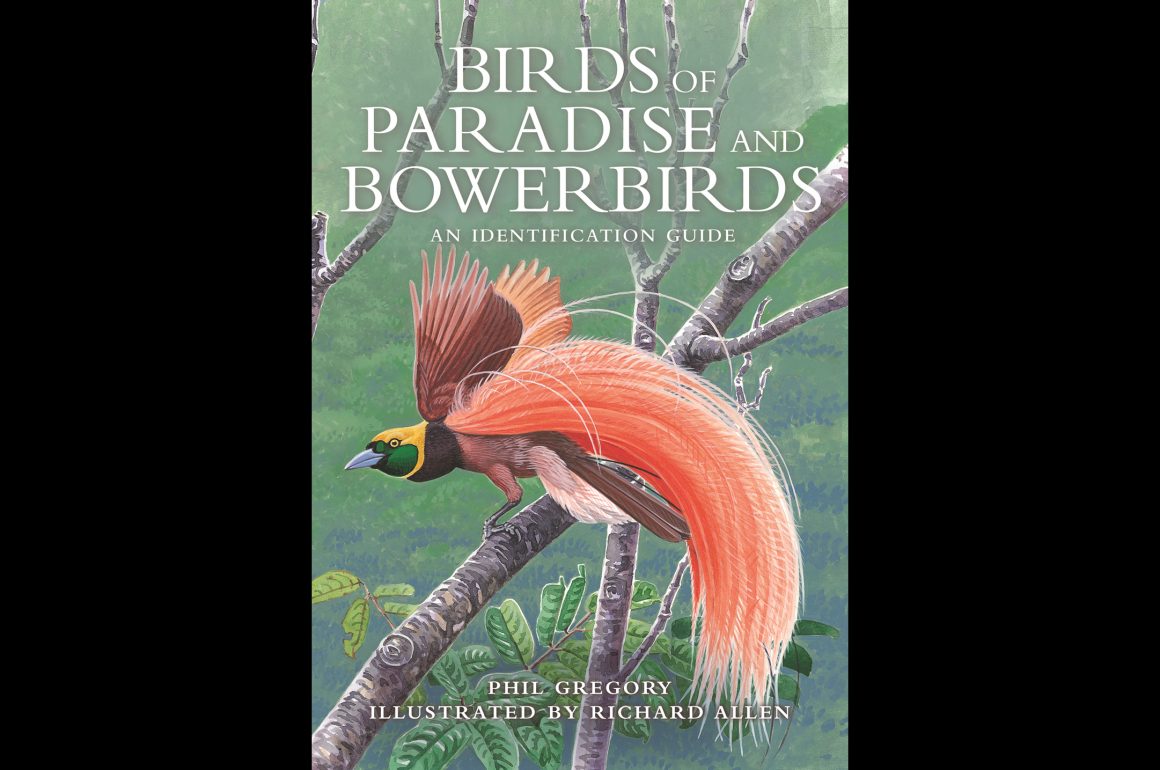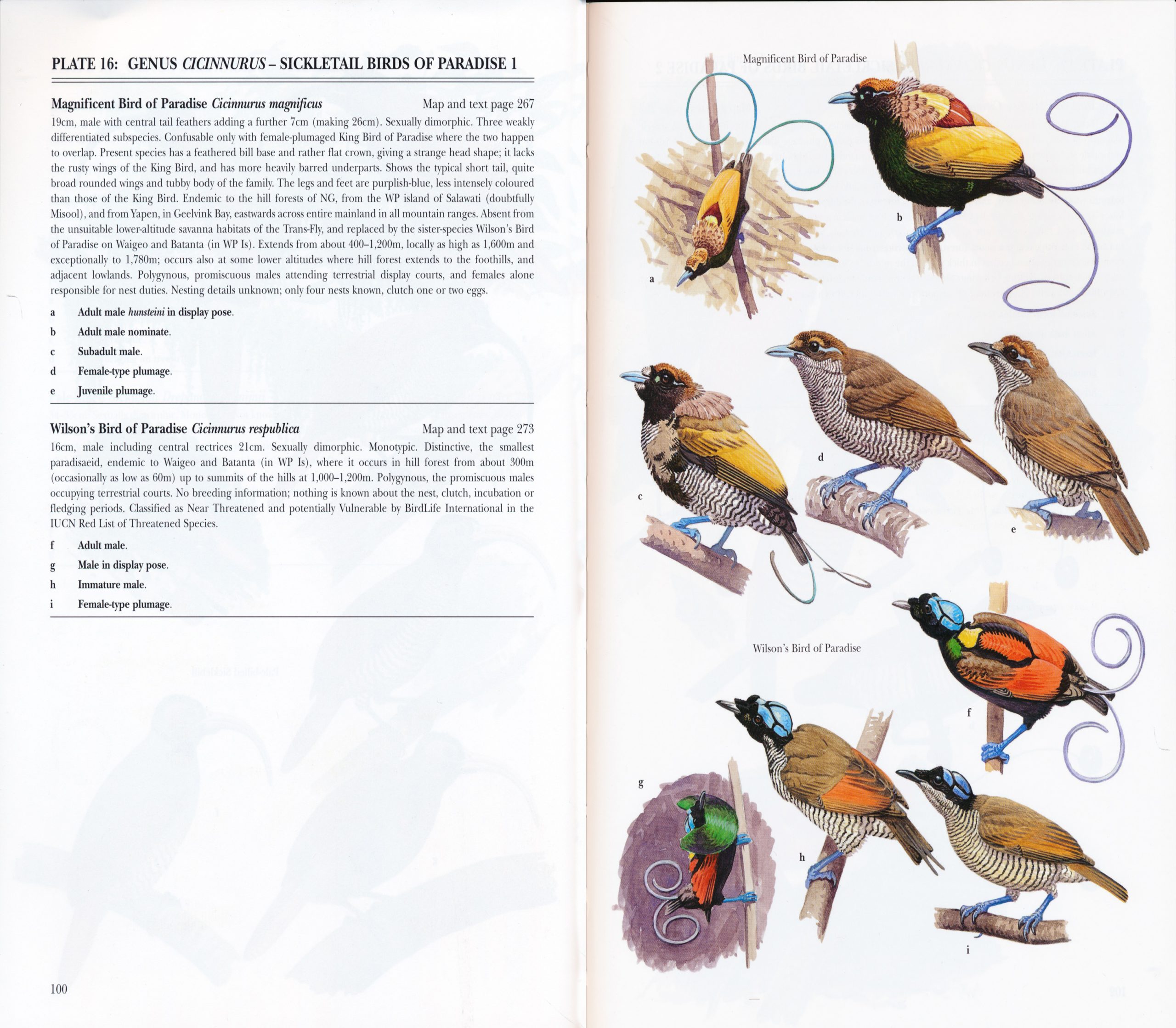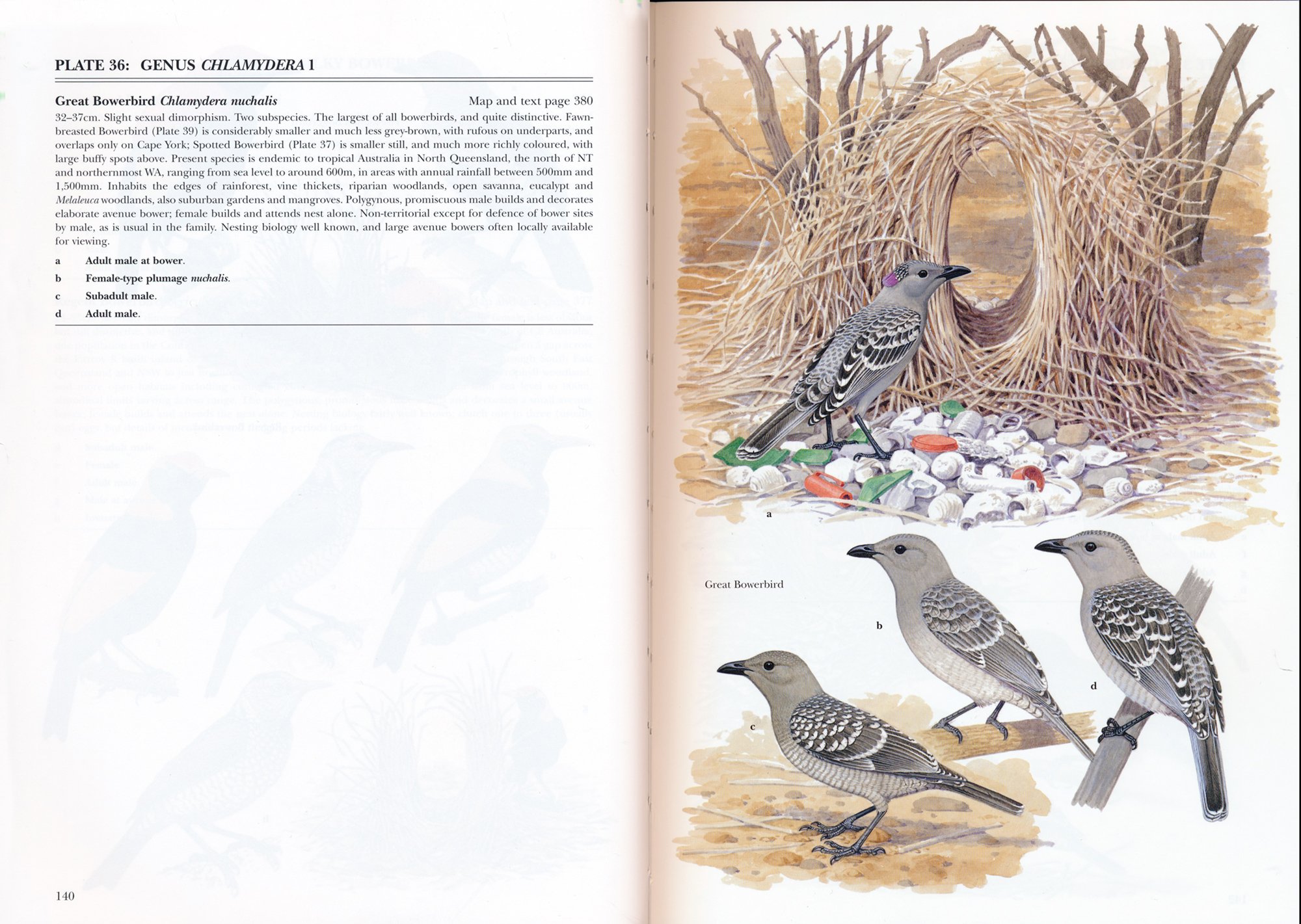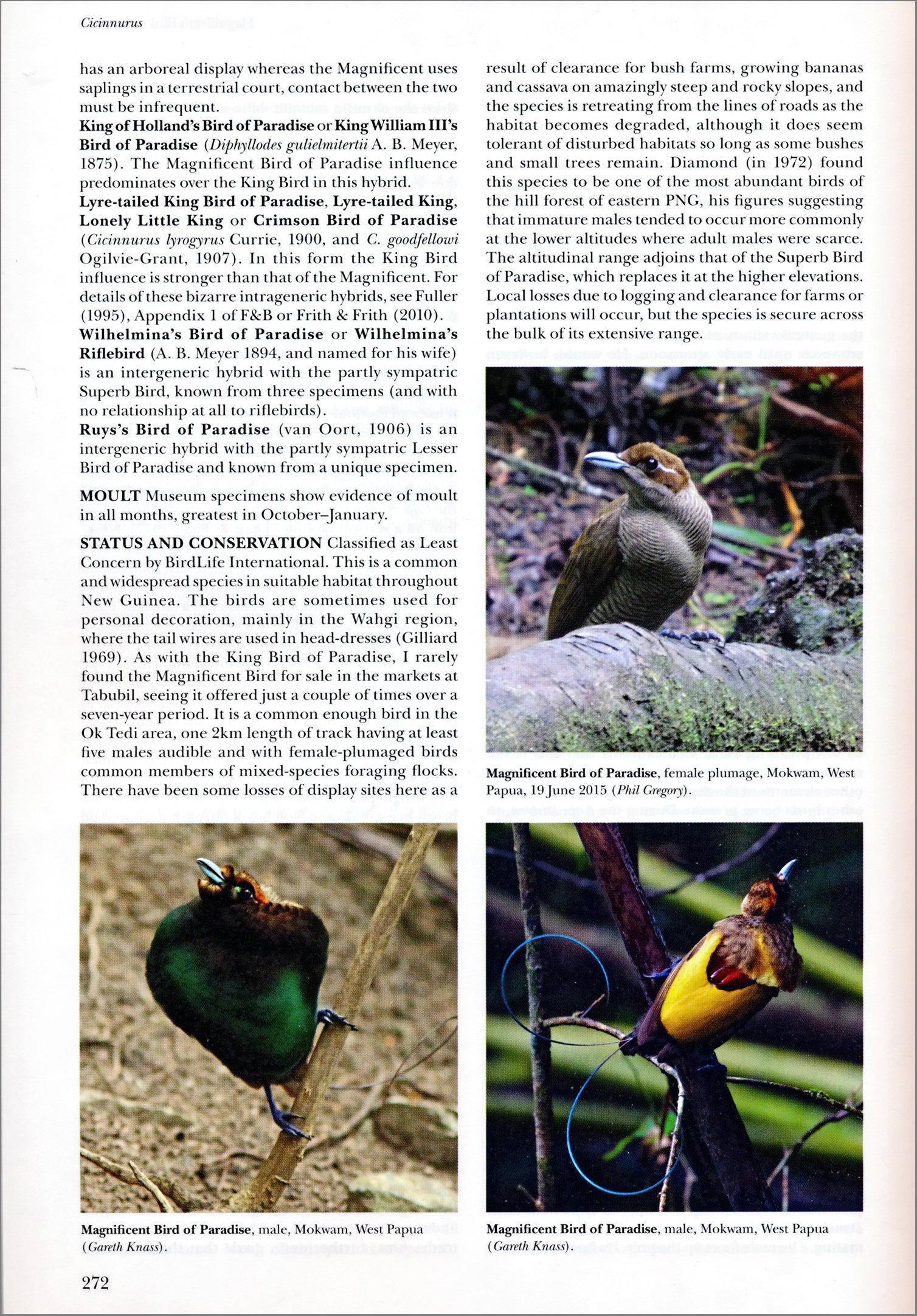
Be careful how you Google ‘bird of paradise’! Type it in and you’ll find articles about a showy South African plant, trailers for two films (one of which was pre-Code and apparently created a sensation), eleven novels, a romance novel series, an animated children’s film, socks, and no less than nine coloring books. It’s the bird family that most people don’t know is a bird family. I didn’t know much about Birds of Paradise either before 2013, when I accompanied a non-birding friend to a presentation at a local college, not really expecting much. The speaker turned out to be Tim Laman, and the topic was the incredible research he and Ed Scholes had spent years doing on birds of paradise in New Guinea. Bowerbirds came to my attention around the same time through the writings of our own Clare M., who has frequently written about Great Bowerbirds, and more recently Satin Bowerbirds.
Birds of Paradise and Bowerbirds: An Identification Guide by Phil Gregory, with illustrations by Richard Allen is a stunning book whose scope goes far beyond the “identification features” we associate with the genre. Like Antpittas and Gnateaters by Harold F. Greeney, also part of the Helm Identification series, it focuses on two avian families, combining the information necessary for identification with the latest research on taxonomy and behavior, particularly breeding behavior, and the latest conservation news and status.
Birds of paradise and bowerbirds are known for their exotic locations (New Guinea and Australia), colorful plumage, and their outlandish courtship behavior–male birds of paradise contort themselves into weird mask-like shapes, flaunt curlicue head plumes or ribbon tails, bugle and rattle and dance to attract mates; bowerbirds create bowers, special spaces and structures decorated with stones of blue, bones, and manmade objects, courting the females attracted to their maypole tents or avenues with a diverse list of mimicked calls. For many years it was thought the two bird families were related taxonomically. They’re not, but their connection through geography (the corner of the universe that encompasses New Guinea and Australia) and complex, cinematic courtship behavior makes their combination in this book rational, even brilliant.
The book covers 77 species; 105 taxa (species and subspecies): 45 Birds of Paradise species, 4 species formerly classified as Birds of Paradise (Satinbirds and MacGregor’s Honeyeater), and 28 Bowerbird species.* It’s divided into four parts: (1) Introductory material; (2) Plates, an 82-page section displaying Richard Allen’s artwork with brief text; (3) Species Accounts, detailed descriptions of each species, illustrated with photographs; back of the book material, including Bibliography, Web Resources, and Index.
Introduction
The introductory material is organized and written clearly, giving both background on the bird families and an explanation of how species-level is organized in the next two sections. It includes a table listing the species, subspecies, author and date of original description, which I found quite handy in sorting out the birds. In Acknowledgements, Gregory not only thanks people, he gives a brief history of how the book came about, something I wish every book had. (Originally enlisted to co-author a book about birds of paradise and bowerbirds with Ian Burrows in 1998, life and work intervened and then Burrows died in 2009; a change in publishing house and editor and more interruptions and the book was finally finished.)
Plate 16: Genus Cicinnurus–Sickletail Birds of Paradise 1; illustration copyright © Richard Allen, text copyright © Phil Gregory
The 40-page Introduction thoroughly discusses ‘the family Paradisaeidae’ (bird of paradise) and ‘the family Ptilonorhynchidae’ (bowerbird), going into detailed explanations of taxonomy, and the development of current taxonomic thought about the two families. These sections can be tough to read if you’re not conversant with taxonomic vocabulary, but I highly recommend reading the pages in the beginning which describe the differences between birds of paradise and bowerbirds. (Amongst other things, bowerbirds use a hide-and-seek type of display and birds of paradise don’t; also, only birds of paradise bugle and only bowerbirds use vocal mimicry).
In addition, the sections review habitat; behavior, including predation, daily routine, food and foraging, and breeding; vocalizations; migration (or, lack of); and conservation. The sections on breeding provide good background for understanding the individual descriptions in the Species Accounts and also a context for understanding these bird’s utility in seeing evolution at work. Gregory notes, for example, that birds of paradise with the most elaborate plumage–dripping plumes, iridescently colored wing feathers, erectile fans–also engage in the most complex displays, because each body part has been modified over the years to play a specific part in that ritualized display. It is, he says, “probably the most extreme examples of sexual dimorphism” (p. 29).
Following Layout and Scope of the Book, there is a list of the major References used in the Species Accounts, a short list of nine titles which saves us the trouble of combing through the lengthier Bibliography at the back of the book. There is also a 12-page Glossary (useful for understanding many of the technical terms in the Introduction) and a List of abbreviations.
Plates
The pages of Birds of Paradise and Bowerbirds burst into life in these pages. Browsing through them, we see the birds’ iridescent yellow-gold, bronzy emerald-green, ashy violet, velvety black, olive-brown to russet-brown plumage; the far-reaching decurved bills of the Sicklebirds and Riflebirds; the crazy head plumes of the male Parotia and even more startling flagged head plumes of the male King of Saxony Bird of Paradise; the wiry tail plumes, varying in degree of curl and length, some ending in thick colored circlets, some wiring around the waterfall of cascading flow of tail feathers of birds of paradise like the one on the book’s cover, Goldie’s Bird of Paradise.
Richard Allen illustrates with the skill of a painter and the heart of a nature lover. These are detailed paintings; he has painstakingly depicted the patterning of bowerbird plumage, often brown on brown and gray on gray–not as showy as bird of paradise plumes and probably more of a challenge. And, just as importantly, Allen places the birds in their habitat and illustrates their behavior, extremely important visuals for these birds, whose behavior and behavioral structures are intricately tied to their being and, from our point of view, their identification. Birds of paradise are shown perching on trees and wooden posts against backgrounds of leaves and forest. The King of Saxony Bird of Paradise portrait is particularly notable, a full-page painting of male, female, and immature male perched on log and vine, one under the other, against an almost impressionistic forest background, the mature male’s flag plumes draping over his family.
Images of typical display poses are included for many of the birds of paradise. Some are large and dominate, like the Twelve-wired Bird of Paradise. Others, like Western Parotia and Superb Lophorina, are small. And, although most of these depictions of bizarre action sequences succeed in giving us some feeling of their delight (Western Parotia, for one), others don’t (I’m looking at the crazy mask that is the Superb Lophorina displaying in front of the female). If I was preparing for a birding trip to Papua New Guinea (and, I hope one day to be doing that), I would supplement these plates with the Laman/Scholes videos available online. (I am puzzled why the Superb Lophorina is not depicted separately in non-display plumage, the only species with this omission. It may be related to the recent split of Superb Bird of Paradise into three species, of which this is one.)
Bowerbird bowers (as Clare M. once reminded me, these are for courtship, not nesting) are a predominant part of those birds’ plates, always showing how the bird would appear within the structure, whether it be a ‘maypole’ type or an ‘avenue’ type. I particularly love the full-page depiction of the Satin Bowerbird, with its blue clothespin, bottlecaps, and feathers.
Plate 36: Genus Chlamydera 1; illustration copyright © Richard Allen, text copyright © Phil Gregory
British illustrator Richard Allen has contributed artwork to A Field Guide to the Birds of South East Asia (2008), Handbook of Birds of the World (Trogons and some Hummingbirds, Lynx Editions), The Birds of the Western Palearctic, Concise Edition (1998), and has solely illustrated Sunbirds: A Guide to the Sunbirds, Flowerpeckers, Spiderhunters and Sugarbirds of the World (2001). On his web site, he says he enjoys “the immediacy of working directly from nature,” which makes his achievements here quite remarkable. Attached to the project since its beginnings, Allen has painted these birds using specimens, photographs, and videos as his source material. He discusses the process in his BirdCallsRadio interview, commenting on how he brought his extensive knowledge of birds, their behavior and anatomy, to bear on understanding how to position the images. Also of use, as Gregory points out in the Introduction, is his experience with painting birds of iridescence, having painted a whole book on sunbirds!
As you can see from the sample plates here, males and females are depicted where appropriate, plus immature birds if needed. Significant subspecies are also shown. Images are labelled with letters, with identifications spelled out on the text page. My preference is to spell out identifications on the image page, but with so few species on each page (one or two), it doesn’t take long to make the connection. And, species names are spelled out on the image page when there are more than one.
The text itself is brief, comparable to information found in larger field guides: common name; scientific name; presence or non-presence of sexual dimorphism; number of subspecies if any (but not names); similar species; distribution; habitat; very brief courtship and nesting information. The reference to the Species Account page and distribution map is easily found, located opposite the boldfaced name.
Species Accounts
From species account for Magnificent Bird of Paradise, Cicinnurus magnificus (pp. 267-272). Photograph copyrights: copyright © Phil Gregory; copyright © Gareth Knass.
Species Accounts are organized by family and genus. Each genus section begins with location(s) of species, a summary of characteristics that the species have in common, some taxonomic history, and other tidbits of interest, like the origin of the name “Riflebird” (actually, there are several possible origin stories given here, all relating the Australian bird to British soldiers).
A species account begins with common (English) name, scientific name, and plate number. This is followed by information on the species’ original description, other names, and etymology of the scientific name. Then, the text sections: Field Identification (most important identification points to know about in the field, including similar birds); Range; Description (extremely detailed, with descriptions for female and juvenile and immature birds); Taxonomy and Geographical Variation (this can be brief or lengthy, depending on if the species is monotypic or divided into subspecies, and if there are subspecies, how much is known about them); Vocalisations [British spelling] and Other Sounds (extremely detailed, includes courtship calls, references to recordings on Xeno-Canto, Macauley Library, and other online sources); Habitat; Habits (flocks or solitary, high or low); Food and Foraging; Breeding Behaviour; Hybrids; Moult; Status and Conservation.
Distribution maps (derived from the maps used for Gregory’s field guide, Birds of New Guinea, Including Bismarck Archipelago and Bougainville (Lynx, 2017), which in turn were updated from Handbook of the Birds of the World) accompany each species account. Numerous photographs illustrate the accounts (and the introductory section), some by Gregory, some by Tim Laman, others by a mix of photographers who are credited under the photo, but whose listing in the Acknowledgments section is missing (unless I’m not seeing it), despite Gregory saying they should be there in the Introduction. I like the combination of artistic plates and photographs from the field. One is useful as a basic reference, the other is useful for preparing you for what you actually will see, if you’re fortunate enough to travel to New Guinea or Australia.
I love reading the descriptions of these birds’ breeding behavior. Though rooted in scientific observation, they have a cinematic quality, encompassing place (especially with the bowerbirds!), movement, sound, and both actors–the male and the female. Significant displays are labelled–there is the Canopy Singing Display, the Bouncing Display, an Initial Bow Display and a Ballerina Pose, Cape Display, Pecking Display, Pulsing Display, Back Display, and Pendulum Display, to cite a few. There are also ‘phases’ of displays, such as the Inverted Phase of the Open Wings Display, where the bird–in this case the King Bird of Paradise–flips under the branch. Here is the shortest description I could find of one display by Victoria’s Riflebird:
When a female arrives on a display post, the male greets her by leaning back and erecting his wings in a Circular Wings Display, with the head and closed bill hidden behind the leading edge of one wing. He may sway his body slowly to one side, and the wings are now held forward of vertical towards the female, forming a kind of shallow dish into which she peers. If the female is nervous the male holds this posture rigidly, but if she seems interested he begins the Alternate Wings Clap Display. (p. 233)
Of course, the best way to study this material is to read the text and then watch a video from the Lab or Ornithology Birds of Paradise Project (Laman & Scholes), National Geographic, or the BBC, who have marvelous footage of birds of paradise in their Planet Earth series. Gregory does reference some of this material, but with the changing nature of websites and social media, this is where YouTube and Google are your friends. It’s also helpful, I think, to read the introductory material on courtship, mentioned in the beginning of this review, both before and after reading the species accounts. Gregory does a great job of providing context for which displays are shared and which are unique to a genus or species.
The material is meticulously documented with citations of monographs by Clifford and Dawn Frith and Bruce Beehler plus additional research papers and materials. There is, of course, great variation in what is known about these species, with some birds, like Victoria’s Riflebird, well-studied and filmed, and other species, like Black-eared Catbird (a New Guinea bowerbird, recently part of a six-way split from Spotted Catbird), still awaiting study. It’s easy to forget that Gregory himself has had years of experience with these birds through his ‘day job’ as a bird tour guide for Field Guides, Inc. and Sicklebill Safaris. But every once in a while, his personal expertise comes through. One example is the Vogelkop Bowerbird account, where he recounts several experiences with the bird and its bowers, including finding “a one-litre clear plastic bottle placed in the hut itself, and our guide assured us that the bird itself had done this!” (p. 357). Later in the section, Gregory gives a lengthy description of a “mixed-object bower” he observed in the Arfak Mountains, worthy of an article in Architectural Digest.
Usability
Although care was clearly taken in the organization of this book, it is not easy to use if you are unfamiliar with the birds’ taxonomic organization. And, considering that this is in flux, changing practically every year, this a weak point. Basically, if you want to look up a species, you need to use the Index. The table of contents is organized by genus: a two-column list gives pages for Plate and Species Accounts for each genus chapter. But, there is no further breakdown by species. The Index lists species by common and scientific name. Curiously, though the scientific name is listed with the species part of the name first (“nuchalis, Chlamydera” not “Chlamydera nuchalis”), the common name is listed as a whole (“Great Bowerbird” not “Bowerbird, Great”). This means that in order to find a specific species, you need to know the exact name–Great Bowerbird, not Super Bowerbird–and you need to know the form of common name selected by the author for use in this book. In the case of Great Bowerbird, this could be Great-Grey Bowerbird, Queensland Bowerbird, Eastern Bowerbird, Western Bowerbird, or Bower Bird. To be fair, Gregory notes that he uses the IOC names from the 2017 checklist and that there is a general consensus amongst authorities on common (English) names. But, what about those of us who aren’t authorities? I’m hoping that in the next edition, there will an entry in the Index for ‘Birds of Paradise’ followed by ‘Lesser,’ ‘Goldie’s,’ ‘Greater,’ etc. and ‘Bowerbird’ followed by ‘Fire-maned,’ ‘Flame,’ ‘Golden,’ ‘Great,’ and so on. (Also, maybe an entry for recent but no longer used common names, like Superb Bird of Paradise?)
Aside from this issue, Birds of Paradise and Bowerbirds is a well-thought out book. Typography, columns, dividers, and headings are used in consistent, non-distracting ways to help us locate images in the Plates section and to focus in on specific information in the dense text of the Species Account. I particularly like the way names of significant behavioral characteristics –types of displays, bower objects and decorative behavior–are bolded and italicized.
Conclusion
Birds of Paradise and Bowerbirds: An Identification Guide by Phil Gregory, with illustrations by Richard Allen is a significant addition to that corner of the universal bird bookshelf where they shelve books about bird families. Although it’s subtitled “an identification guide,” it is really a concise integration of research, organized to highlight facts about habitat, plumage, behavior, and taxonomic relationships–all the material a researcher or birder needs to prepare for a trip to New Guineas and/or Australia. (And, I suppose in the field if you have a strong back, but this isn’t really a field guide.) Allen’s illustrations are beautiful (I really covet a print of that King of Saxony Bird of Paradise plate) as well as scientific. Phil Gregory brings years of field experience to this project. He’s also done his homework in terms of research and writing; he was a major contributor to the sections on birds of paradise and bowerbirds for Handbook of Birds of the World and, as mentioned above, recently authored the Lynx Birds of New Guinea, Including Bismarck Archipelago and Bougainville. Gregory’s text is comprehensive and readable with little reliance on technical language (except for the taxonomic sections).
This is not an inexpensive book. However, I expect it will be the standard guide for these avian families for many years. If you are planning to visit New Guinea and Australia and if one of your prime goals is to observe these incredible birds, I think they are well worth the money. Just think–you’ll be the only one in your group who will be able to differentiate a Cape display from a Circular Wings display!
—–
* There are some conflicts in these numbers. The table of “the species and subspecies of birds of paradise” lists 71 taxa, but Gregory says the book covers 72 taxa in Layout and Scope of the Book (p. 52). Also, marketing material for the book says it covers “108 recognized taxa in the two groups” but the species and subspecies in the table of species and subspecies adds up to 105.
Thank you to Princeton University Press for permission to reproduce select pages from Birds of Paradise and Bowerbirds: An Identification Guide by Phil Gregory, illustrated by Richard Allen. Copyright © 2020 by Princeton University Press. Reprinted by permission.
Birds of Paradise and Bowerbirds: An Identification Guide
By Phil Gregory; Illustrated by Richard Allen
Princeton University Press, 2020 (published in Europe by Helm)
ISBN-10: 0691202141; ISBN-13: 978-0691202143
Hardcover; 416 pages; 6.75 x 1.2 x 9.8 in.; Illus: 40 color plates. 151 color photos.
$45.00; discounted from the usual sources
















Leave a Comment